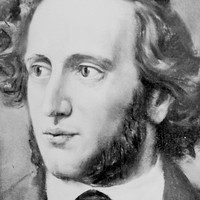Mendelssohn’s Octet



Shostakovich entered the Petrograd Conservatory in 1919, at the age of thirteen. He overcame the death of his father in 1922, a bout of tuberculosis in 1923, and ever-precarious family finances (toward the alleviation of which he contributed by accompanying silent movies), before graduating at age nineteen. While he was composing his valedictory Symphony No. 1 in 1924-25, he also worked on what was meant to be a five-movement suite for string octet. He completed the Prelude in 1924 and then stalled on a fugue; the Scherzo followed the next year, at which point Shostakovich closed the work in its two-movement form. He declared the Prelude and Scherzo “the very best thing I have written”—quite a claim considering the monumental symphony he had recently completed.
Shostakovich’s Prelude builds from the tradition of Bach, with hints of a Baroque style mingling with more recent Romantic influences. The movement proceeds through a string of large-ensemble declamations, free-flying solo excursions, and a pressing central interlude. The edgy Scherzo follows as a diabolical romp through wide-ranging textures, colors, and moods. Coming a dozen years before the first of his fifteen string quartets, this early work reveals the burgeoning voice of one of the century’s greatest chamber music composers.
Aaron Grad ©2014

Mendelssohn’s reputation as Western music’s greatest prodigy could rest on the magnificent Opus 20 Octet alone, for it far exceeds any accomplishment of Mozart, Schubert, or any other wunderkind by the age of sixteen. But more than an impressive show of precocity, the Octet is bona fide masterpiece irrespective of the composer’s age.
Throughout the work, Mendelssohn displays an uncanny mastery of sonority, exploring the various textures afforded by the ensemble at hand. Witness its unforgettable opening, first violin soaring above expectant tremolandi. A crooning duet between fourth violin and first viola introduces the lyrical second theme. As Mendelssohn develops this idea, the first violin continues to comment with fragments of its cavalier opening melody. The movement’s development section is rife with Beethovenian Sturm und Drang; tentative syncopations build to an exhilarating crest, as all eight parts come together in a fortissimo sixteenth-note run to the recapitulation.
The thoughtful Andante provides a foil for the first movement’s forward thrust. Without losing anything of the ensemble’s expres¬sive capacity, Mendelssohn pares down the octet texture to achieve heartrending subtlety and delicacy.
From the composer’s sister Fanny Mendelssohn, we have insight into the creative impetus behind the fleet scherzo. Fanny writes that Felix “set to music the stanza from Walpurgis Night’s Dream in [Goethe’s] Faust:
The flight of the clouds and the veil of mist Are lighted from above. A breeze in the leaves, a wind in the reeds, And all has vanished.
To me alone he told this idea: the whole piece is to be played stac¬cato and pianissimo with shivering tremolos and lightning flashes of trills. All is new, strange, and yet so familiar and pleasing—one feels so close to the world of spirits, lightly carried up into the air. Indeed one might take a broomstick so as to follow the airy procession. At the end the first violin soars feather-light aloft—all is blown away.”
An arresting fugue launches the Presto finale. But just as Mendelssohn’s deft counterpoint and fugal technique suggest his deep study of Bach, so does the symphonic breadth of the Octet’s finale reveal the influence of Beethoven. For¬tissimo octaves across the full ensemble punctuate the opening fugato, emitting a caffeinated energy that continues unrelenting for the remainder of the work. Near the end, Mendelssohn reintroduces the scherzo melody, transport¬ing the listener back to the enchanted world of the third movement before bringing the magnificent Octet to its thrilling conclusion.
Patrick Castillo ©2016
Get driving directions and find nearby parking.
Find dining options close to the venue.
View seating charts to find out where you'll be seating.
Get driving directions and find nearby parking.
Find dining options close to the venue.
View seating charts to find out where you'll be seating.
